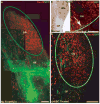Increased chondroitin sulfate proteoglycan expression in denervated brainstem targets following spinal cord injury creates a barrier to axonal regeneration overcome by chondroitinase ABC and neurotrophin-3
- PMID: 17540369
- PMCID: PMC2270474
- DOI: 10.1016/j.expneurol.2007.03.029
Increased chondroitin sulfate proteoglycan expression in denervated brainstem targets following spinal cord injury creates a barrier to axonal regeneration overcome by chondroitinase ABC and neurotrophin-3
Abstract
Increased chondroitin sulfate proteoglycan (CSPG) expression in the vicinity of a spinal cord injury (SCI) is a primary participant in axonal regeneration failure. However, the presence of similar increases of CSPG expression in denervated synaptic targets well away from the primary lesion and the subsequent impact on regenerating axons attempting to approach deafferented neurons have not been studied. Constitutively expressed CSPGs within the extracellular matrix and perineuronal nets of the adult rat dorsal column nuclei (DCN) were characterized using real-time PCR, Western blot analysis and immunohistochemistry. We show for the first time that by 2 days and through 3 weeks following SCI, the levels of NG2, neurocan and brevican associated with reactive glia throughout the DCN were dramatically increased throughout the DCN despite being well beyond areas of trauma-induced blood brain barrier breakdown. Importantly, regenerating axons from adult sensory neurons microtransplanted 2 weeks following SCI between the injury site and the DCN were able to regenerate rapidly within white matter (as shown previously by Davies et al. [Davies, S.J., Goucher, D.R., Doller, C., Silver, J., 1999. Robust regeneration of adult sensory axons in degenerating white matter of the adult rat spinal cord. J. Neurosci. 19, 5810-5822]) but were unable to enter the denervated DCN. Application of chondroitinase ABC or neurotrophin-3-expressing lentivirus in the DCN partially overcame this inhibition. When the treatments were combined, entrance by regenerating axons into the DCN was significantly augmented. These results demonstrate both an additional challenge and potential treatment strategy for successful functional pathway reconstruction after SCI.
Figures









Similar articles
-
Large-scale chondroitin sulfate proteoglycan digestion with chondroitinase gene therapy leads to reduced pathology and modulates macrophage phenotype following spinal cord contusion injury.J Neurosci. 2014 Apr 2;34(14):4822-36. doi: 10.1523/JNEUROSCI.4369-13.2014. J Neurosci. 2014. PMID: 24695702 Free PMC article.
-
Axonal regeneration through regions of chondroitin sulfate proteoglycan deposition after spinal cord injury: a balance of permissiveness and inhibition.J Neurosci. 2003 Oct 15;23(28):9276-88. doi: 10.1523/JNEUROSCI.23-28-09276.2003. J Neurosci. 2003. PMID: 14561854 Free PMC article.
-
Axonal regeneration of Clarke's neurons beyond the spinal cord injury scar after treatment with chondroitinase ABC.Exp Neurol. 2003 Jul;182(1):160-8. doi: 10.1016/s0014-4886(02)00052-3. Exp Neurol. 2003. PMID: 12821386
-
Advances in chondroitinase delivery for spinal cord repair.J Integr Neurosci. 2022 Jun 24;21(4):118. doi: 10.31083/j.jin2104118. J Integr Neurosci. 2022. PMID: 35864769 Review.
-
Scar-mediated inhibition and CSPG receptors in the CNS.Exp Neurol. 2012 Oct;237(2):370-8. doi: 10.1016/j.expneurol.2012.07.009. Epub 2012 Jul 24. Exp Neurol. 2012. PMID: 22836147 Free PMC article. Review.
Cited by
-
Chondroitinase ABC promotes selective reactivation of somatosensory cortex in squirrel monkeys after a cervical dorsal column lesion.Proc Natl Acad Sci U S A. 2012 Feb 14;109(7):2595-600. doi: 10.1073/pnas.1121604109. Epub 2012 Jan 30. Proc Natl Acad Sci U S A. 2012. PMID: 22308497 Free PMC article.
-
Immature astrocytes promote CNS axonal regeneration when combined with chondroitinase ABC.Dev Neurobiol. 2010 Oct;70(12):826-41. doi: 10.1002/dneu.20820. Dev Neurobiol. 2010. PMID: 20629049 Free PMC article.
-
Enhancement of Neuroglial Extracellular Matrix Formation and Physiological Activity of Dopaminergic Neural Cocultures by Macromolecular Crowding.Cells. 2022 Jul 6;11(14):2131. doi: 10.3390/cells11142131. Cells. 2022. PMID: 35883574 Free PMC article.
-
Synaptic plasticity, neurogenesis, and functional recovery after spinal cord injury.Neuroscientist. 2009 Apr;15(2):149-65. doi: 10.1177/1073858408331372. Neuroscientist. 2009. PMID: 19307422 Free PMC article. Review.
-
Neural glycomics: the sweet side of nervous system functions.Cell Mol Life Sci. 2021 Jan;78(1):93-116. doi: 10.1007/s00018-020-03578-9. Epub 2020 Jul 1. Cell Mol Life Sci. 2021. PMID: 32613283 Free PMC article. Review.
References
-
- Aldskogius H, Kozlova EN. Central neuron-glial and glial-glial interactions following axon injury. Prog Neurobiol. 1998;55:1–26. - PubMed
-
- Biber K, Dijkstra I, Trebst C, De Groot CJ, Ransohoff RM, Boddeke HW. Functional expression of CXCR3 in cultured mouse and human astrocytes and microglia. Neuroscience. 2002;112:487–497. - PubMed
Publication types
MeSH terms
Substances
Grants and funding
LinkOut - more resources
Full Text Sources
Medical
Miscellaneous

